Contemporary Church History Quarterly
Volume 24, Number 4 (December 2018)
Review of Dirk Schuster, Die Lehre vom ‘arischen’ Christentum: Das wissenschaftliche Selbstverständnis im Einseacher ‘Entjudungsinstitut’ (Göttingen: V&R Unipress, 2017)
By Susannah Heschel, Dartmouth College
Scholarship on the pro-Nazi Deutsche Christen (DC), the German Christian Movement, began slowly in the postwar years, but has been growing and adding considerable new information to our understanding of the history of Christian theology and the role of the German churches during the Third Reich,
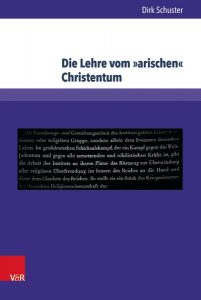 With the excellent new book by Dirk Schuster, the scholarship reaches an important milestone. The apologetic tone is entirely absent and instead we have a work by a very thoughtful scholar who examines archival data, weighs and evaluates new evidence, and draws sharp and strong conclusions. Schuster represents a new generation of young German scholars seeking historical accuracy rather than defending the church or making excuses for individual theologians.
With the excellent new book by Dirk Schuster, the scholarship reaches an important milestone. The apologetic tone is entirely absent and instead we have a work by a very thoughtful scholar who examines archival data, weighs and evaluates new evidence, and draws sharp and strong conclusions. Schuster represents a new generation of young German scholars seeking historical accuracy rather than defending the church or making excuses for individual theologians.
Breakthroughs in the scholarship on the churches during the Third Reich came with publications by several North American scholars for whom racism and antisemitism were central to the history of National Socialism and whose academic careers were not dependent upon pleasing church officials. The first breakthrough was Robert Ericksen’s masterful and widely read 1985 book, Theologians Under Hitler, that described in clear and careful detail the work of three highly influential Protestant theologians in Germany: Kittel, Paul Althaus, and Emanuel Hirsch. Ericksen analyzed the writings of each, demonstrating the nature of the theological support given by each man to the Nazi regime, as well as the consequences each suffered after the war. The second major contribution was a study of overall DC theology by Doris Bergen in her magisterial 1996 book, Twisted Cross, which made extensive use of published and unpublished DC materials that had been deposited after the war in an archive in Minden, Germany. Bergen argued that three elements characterized the theology of the DC: it was anti-doctrinal, antisemitic, and wanted a manly church. A third breakthrough was the massive and detailed study of the Protestant churches in Berlin undertaken by Manfred Gailus, the German social historian, that demonstrated far greater support for the DC than anyone had ever imagined. More recently we have additional important work: Kyle Jantzen’s analysis of the pastorate, Charlotte Methuen’s study of church architecture during the Third Reich, Anders Gerdmar’s study of German biblical interpretation, among many others.
I came to the topic during the late 1980s, as I was finishing my doctoral dissertation about the German-Jewish theologian Abraham Geiger and the reception of his work among Protestant theologians in the nineteenth century. While browsing in a Berlin library, I came across a volume of articles by German Protestants edited by Walter Grundmann and published in 1942 by the “Institut zur Erforschung des jüdischen Einflusses auf das deutsche christliche Leben.”
At a conference convened by Leonore Siegele-Wenschkewitz at the Evangelische Akademie in Arnoldshain in 1990 on the German Protestant theological faculties during the Third Reich, I asked several senior scholars, including Kurt Meier and Kurt Nowack, both from Leipzig, about the Institute. The answer was uniform: this was a marginal, unimportant Institute; the archives had entirely disappeared; the topic was not worth pursuing. I received a similar response a few months later from the Canadian historian John Conway. Nonetheless, I persevered and discovered material about the Institute in the central church archives in Berlin. In 1991 I traveled to Eisenach, where the Institute had been headquartered, and found additional bits of material in the church archives of Thuringia. The archivist was discouraging, claiming to have nothing substantial, but as I traveled to university, state, and local archives around Germany in subsequent years, thanks to a series of travel grants, I discovered more and more documentation, especially at the University of Jena archives. The archivist in Eisenach, managed to locate additional documents–bits of letters, memoranda, manuscripts. Little of the material had been formally catalogued by the archive, and no one had as yet asked to read it. I gradually pieced together an ugly story of antisemitic propaganda, written by theologians and pastors, in support of the Nazi war effort.
During the years of my research on the book I eventually published, The Aryan Jesus: Christian Theologians and the Bible in Nazi Germany, I would show copies of the documents I had unearthed to an older, prominent Protestant theology professor in Berlin whom I had long viewed as a mentor. As someone deeply engaged in Christian-Jewish relations, he was surprised and shocked to discover that Grundmann, whose Gospel commentaries had long been required reading of pastors and theologians, had been a Nazi propagandist. However, I soon discovered that this professor appropriated my topic, went to the archives I had discovered, and published the material without crediting or thanking me. An unpleasant and not unique academic experience but heightened by the nature of the topic and by the history of German treatment of Jews, including of my own family.
Now, a new generation has taken up the topic. Oliver Arnhold’s two-volume study ignores the English-language scholarship entirely and claims the Institute was formed in opposition to neo-pagan groups rather than its stated purpose, to rid Germany of Jewishness. Roland Deines, a New Testament scholar, blames the Jews for Grundmann’s antisemitism. Deines argues that Grundmann took his claim that Jesus was Aryan from Heinrich Graetz, the noted German-Jewish historian of the nineteenth century, who presented Jesus as a Galilean. The obvious difference between a nineteenth-century Jewish scholar calling Jesus a Galilean and a Nazi-era Protestant scholar calling Jesus an Aryan–precisely in an era when “Aryan” was lifesaving and “Jew” was a death sentence–seems to have evaded him.
Schuster’s book is all the more refreshing thanks to his pointed critique of prior, apologetic scholarship, a critique fully supported by the evidence he carefully presents. Situating the Institute squarely in its time and place–Nazi Germany–he does not try to hide its antisemitism under the fig leaf of nationalism as so many others have done, from Kurt Meier to Robert Morgan. There are moments when he might have added relevant data, such as Nazi party, SA, or SS membership, that is easily procured from my own book, but such data is often missing from German publications about the church because it is still not easy to secure such membership information.
In these days of ‘fake news,’ Schuster points to a similar concept employed by some of the pro-Nazi DC theologians. That Jesus was thought to be a Jew was a falsification that occurred, they claimed, because Jews had inserted fake, pro-Jewish passages into the Gospel texts in antiquity; they now promised to restore the “correct” text. Schuster demonstrates that Nazi racism regarding “the Jew” was transported by Institute theologians to antiquity and claimed as objective, scientific “reality” demonstrated by their “scholarship”–whereas all other scholarship that demonstrated the Jewishness of Jesus and early Christianity was false. Thus, the Institute created Christianity as a religious expression of Aryans–that is, the religion of the German Volk–and Judaism as its negative opposite (249). Creating an understanding of Christianity as Aryan involved a host of scholars from a range of fields, including theology, history, linguistics, archeology, and more.
Some of the material that Schuster presents has already been discussed by other scholars, yet he is able to reframe the material in such a creative and original way that his book is a must-read even for those familiar with the antecedent studies. The “Aryan Christianity ” that he examines is not simply an expression of an over-zealous German nationalism, nor the outgrowth of an inner-Protestant conflict, nor an effort to protect the church from Nazi hostility, but rather an outgrowth of new scholarly methods, including the methods of the History of Religions School and the “Erforschung der Judenfrage” that flourished during the Nazi era, as Dirk Rupnow has magnificently delineated in his important 2011 book, Judenforschung im Dritten Reich. Schuster examines members of the Institute and uncovers their shared roots as former students and researchers at the Universities of Leipzig and Tübingen whose academic orientation was rooted in History of Religions methods. Most important, Schuster reveals antisemitic structures of argumentation in their “scholarship.”
The History of Religions methods were thought by many theologians to provide a tool for overcoming divisions within Germany (e.g., Catholic-Protestant). This was not simply a field or division within a faculty, but scholarship with a social and political purpose. It was diverse, to be sure, but it was politicized and fit comfortably with the National Socialist regime.
Schuster notes that German nationalism from the outset was bound up with theological and biblical motifs, as numerous scholars have demonstrated. Indeed, the series of wars that led ultimately to German unification were conducted against Catholic countries–Austria-Hungary and France. Unification, moreover, brought renewed calls for unifying German Catholics and Protestants into a “Volkskirche” or “Nationalkirche” (46). Calls came from the beginning of the twentieth century, growing during World War One, to liberate the German Protestant church from foreign influences. Standing behind the call for a “Verdeutschung des Christentums” was an antisemitic worldview and a call to eliminate the OT from liturgy and sermons and understand Jesus to have been an Aryan, not a Jew (49). This was not only, Schuster writes, a rejection of Jewish influences within Christianity, but far more, a direct Bekämpfung (fight) against Judaism.
No distinction remained between religion and politics as the notorious Thuringian German Christian movement took shape under the leadership of the two Bavarian pastors who moved to the Werra Valley, Siegfried Leffler and Julius Leutheuser, both of whom served as Leiter of the local Nazi party Gau. Hitler was viewed as a continuation of Jesus and Luther, and the Nazi movement as a divine revelation that would resurrect Germany out of the Weimar Republic; Hitler was God’s tool, they believed. The Thuringian DC came to dominate through the late 1930s and its orientation was thoroughly racist. There should be a church for each Volk, and the church for the German Volk should finally overcome the division between Catholic and Protestant in one Nationalkirche.
The November 1938 pogrom left the remaining Jews marginalized and, as Hans Mommsen put it, under the jurisdiction of the Gestapo (70). Germany was to be rid of its Jews, and the formation of a dejudaization institute by theologians in 1939 was a logical culmination of the virulent idea of a Christian “Entjudung” that had circulated since the beginning of the twentieth century as well as a consequence of the Nazi policy of making Germany Judenrein.
Schuster emphasizes the Institute’s origins as an enthusiastic response to the 1938 November pogrom, demonstrating its “direkt Reaktion auf die antisemitischen Gewaltmassnahmen des NS-Staates” (74). Furthermore, the Institute was no marginal phenomenon with a brief lifespan, but “an integral component of the Protestant theological scholarly community” (83). Copies of its dejudaized New Testament and hymnal were sold widely throughout the Reich–500,000 copies of the hymnal were sold by early 1944 (86).
Throughout its conferences and numerous publications intended for both lay and clerical audiences, members of the Institute developed a racist hermeneutics. Heinz Eisenhuth (1903-83), professor of systematic theology at the University of Jena, argued that the Old Testament expressed a “foreign racial soul” (99) and that Jews, after baptism, nonetheless remain Jews (89). Such arguments were translated into policy by many of the regional churches. On December 17, 1941, the churches of Thuringia, Mecklenburg, Saxony, Nassau-Hessen, Anhalt, and Lübeck issued an official notice that “racially Jewish Christians” had no place in the church (91). Note the date: precisely on the eve of Nazi deportations of Jews from the Reich, just when the death camps were beginning their operations, Christians were told that baptized Jews were not Christians; moral duty toward them was not necessary.
Was this a theological effort to distance Christianity from Judaism, a revision of New Testament scholarship? The roots of the scholars who participated in Institute-sponsored conferences and publications were mostly within liberal Protestant historical-critical method, but it would be a mistake to understand their efforts as sincere but misguided scholarship. In an extremely important section of his book, Schuster presents conclusive evidence from letters as well as published materials that the ultimate goal of the Institute, as its own members understood it, was as an “integral component of the entire political development” of the Nazi regime and offer “respectability” to its antisemitic measures. (122). They saw themselves contributing to the war effort: just as Germany was fighting on the military battlefield, they were fighting on the spiritual battlefield, they would say.
Schuster is careful not only to examine the writings of Walter Grundmann, the academic director of the Institute, but also to detail the writings of several of its members and to evaluate the contribution each one made to the goals of the Institute. He uncovers important new information. For example, Grundmann planned an Institute-sponsored German translation of the Talmud Yerushalmi and engaged a young scholar, Rudolf Meyer, who had training in Hebrew, to work with him on that project–though it was never completed due to Meyer’s conscription into the Nazi military. Schuster notes that similar such Talmud projects had been undertaken by other antisemitic “pseudo-research” institutes supported by the Nazi regime and helpfully links the work of the Institute with the widespread “Judenforschung” of the Nazi era that Rupnow analyzes. Another young scholar, a student of Meyer’s, who was going to participate in the projected Talmud project was Siegfried Morenz, though Schuster notes that his involvement may have been motivated by an effort to promote his career than by antisemitic motivations. Schuster gives careful attention not only to the motivations of each scholar, but also to their postwar publications, noting continuation of Nazi-era arguments, purged of Nazi language (such as “Aryan”), that insist on an essentialized and negative “Judaism.” That they continued to argue for a dejudaized Christianity even after 1945 makes it clear that they were not simply responding to the politics of the moment, but sincerely believed in the theology they were presenting.
Schuster has done an excellent job placing the theological effort to dejudaize Christianity into larger contexts, including the Judenforschung that Rupnow outlines; German nationalism’s reliance on religion, as demonstrated by Hartmut Lehmann; and the History of Religions School, as discussed by Horst Jünginger. He is clear that the Institute was antisemitic and a direct response to Nazi antisemitic politics. Still, there are questions left regarding motivations. What did these theologians ultimately hope to accomplish? Certainly there was a desire to achieve recognition from the regime–to become “Bonzen” (big shots)–which did not happen, and yet they persisted despite the lack of recognition and even efforts by the regime against them (spying by the Gestapo, conscription into military service). Perhaps they were hoping for recognition from their colleagues, considering themselves theological pioneers paving new methods of historical analysis and textual exegesis. Yet their methods were ultimately neither new nor particularly sophisticated, but, rather, tendentious, built on speculation rather than evidence and driven by a pervasive, demagogic insistence on the degeneracy and danger of Judaism. In that respect, their work coalesced not only with what Hitler was doing at the moment, but with a longer tradition regarding Judaism within Christian scholarship that had not been challenged by any leading theologian. To have objected would have required support from some sort of authority, whether from Luther or from more recent theologians or from the New Testament itself. Yet no positive affirmations of Judaism could be mustered within the Christian theological tradition, and the Old Testament itself had been so terribly marginalized and even denigrated that its elimination brought a sense of religious relief.
One of the important accomplishments of Schuster’s contribution is his emphasis on the role of the Institute. This was not a marginal phenomenon. On the contrary, its influence was widespread, as he demonstrates by pointing to the enormous success of its publications, its large membership, the postwar careers of its members, but, most important, because its effort to dejudaize fit so easily into the wider framework of German antisemitism and Christian theological arguments against Judaism.
What motivated these scholars? Schuster agrees with what has already been argued by other scholars: they were motivated by career advancement, by antisemitism, by an opportunistic desire for publicizing their ideas, by anti-Communism, by loathing for the Weimar Republic, and by a Nazi regime that was both thrilling, at least in its early years, and practical, creating new academic opportunities by firing Jewish academics.
The postwar years brought new prospects and few hindrances to denazification. Jobs were lost, jobs were gained, politics of state and church were manipulated, and exculpatory self-justifications were written–most were successful. These theologians were no different from other scholars who lost or retained their university positions and academic stature–except that the theologians could appeal not only to state officials but to church officials as well. Thus, Grundmann lost his university professorship, but the church of the German Democratic Republic (GDR) employed him as professor at various seminaries, his numerous books were published and sold throughout German-speaking Europe, and he was regarded at the GDR’s most prominent theologian. Success was achieved by claiming “resistance” as a Christian against the Nazi regime, despite the fact that these theologians flourished thanks to that very regime.
The DC has been explained in a variety of ways. Its members presented themselves after 1945 as defenders of the church against Nazi anti-Christian efforts. They were at times exonerated for their pro-Nazi efforts by postwar state officials who described them as “naïve” theologians who did not understand politics. Church officials and theologians rarely recognized the antisemitism at the heart of their writings, accepting the self-defense of DC members that they were historians who were simply clarifying Christianity’s distinctiveness from Judaism, despite the fact that Grundmann, for instance, warned of the “syphilization” of Germany by the Jews, hardly a theological argument.
Schuster is clear about the different motivations of the seven theologians whose careers and writings he examines in detail–career opportunism and antisemitism were prime among them. Yet he is also clear about his most important claim: that the effort to create an Aryan Christianity was not simply a product of Nazi politics, but an outgrowth of Protestant theology. Not only was it not simply a Nazi product; the ideas he traces during the Nazi era continued after 1945. Schuster’s study leads to the question of why these (mostly) Protestant (mostly Lutheran) theologians, primarily in Germany, but also in Scandinavian countries, were so committed to antisemitic theology. For Schuster, the answer is twofold. Protestantism had long denied a continuity from Old to New Testament, preferring to see the Old Testament as a “foreign text” and Judaism as overcome and negated through Christianity’s supersessionism (286). Moreover, he argues, what the Nazi era accomplished was to make possible the ultimate “proof” of an Aryan Christianity by granting DC theologians professorships and by promoting the work of the Institute. I would add additional motivations, including the sense within the church at the turn of the century that racial theory was new and sophisticated, so that racializing theology was seen as a method for modernizing Christianity. Racial theory was also a way to preserve the uniqueness of Jesus from claims by Jewish historians that his teachings were no different from those of other rabbis of his day. Inflammatory antisemitism was a way to arouse the pews to emotional engagement, in contrast to fine points of exegesis or doctrine. Given the mood in Germany during the first decades of the twentieth century, antisemitism provided a scapegoat, a mood of excitement, and an explanation for problems.
Very little theological opposition to the Institute was published during the war years–some negative book reviews–and once former Confessing Church members took control of the Thuringian church after the war, efforts to keep it going were not successful, despite disingenuous claims that its dejudaization program was a purely scholarly effort. However, the continuation of its arguments into acceptable language was not difficult, as Schuster demonstrates, and Institute members published major works of scholarship in the postwar decades, as he notes. The reception of those works deserves further attention, as does the involvement of some Institute members in Dead Sea Scroll scholarship. Nor should their dejudaization efforts be understood solely as a product of DC scholarship; plenty of their opponents in the Confessing Church articulated highly negative claims about Judaism, though not with an intention of dejudaizing Christianity or removing the Old Testament from the Christian Bible.
That leads to the postwar question awaiting future scholarship: why were such Christian antisemitic ideas promoted after 1945 in both the anti-fascist German Democratic Republic and the democratic Federal Republic of Germany? Why does the negation of the Old Testament continue, exemplified by the recent call by Notger Slenczka, professor of theology at the Humboldt University, to remove the Old Testament from the Christian Bible. Schuster concludes with caution, noting that what passed for theological scholarship in the 1930s would not be acceptable scholarship today, and also warning of the danger of attributing an inherent, indelible “character” to any religion. The mixture of politics and theology, and a political regime that fosters inhumane theological claims is the heart of the danger, one that requires careful monitoring. The wish to remove Judaism from Christianity was not limited to the Third Reich, and Schuster has written a thoughtful and insightful analysis probing the danger of what happened when that wish was fulfilled.

 A few key conceptions and realities are at the forefront of Junginger’s study, which is a translation of a revised version of the author’s Habilitation thesis. First, the author seeks to demonstrate that Nazi-era “Jew research,” which purported to pose scholarly answers to the “Jewish Question” but in fact aimed at supporting anti-Jewish policies – was carried out at German universities in a manner that mutually reinforced religious and racial antisemitism. Thus, the book focuses on the religious aspect of modern antisemitism – even while recognizing with great care that “religious stereotypes coalesce with a racial explanation of the world” (ix). Second, the University of Tübingen’s centuries-long role as “an intellectual stronghold against Judaism” (x) culminating in its essential function as a locus of Nazi Judenforschung, is emphasized. Finally, theoretical and practical antisemitism converged during the Holocaust, as typified here by Junginger’s examination of the biographies of roughly a dozen war criminals who, the author demonstrates, were responsible for the deaths of several hundred thousand European Jews during the Shoah.
A few key conceptions and realities are at the forefront of Junginger’s study, which is a translation of a revised version of the author’s Habilitation thesis. First, the author seeks to demonstrate that Nazi-era “Jew research,” which purported to pose scholarly answers to the “Jewish Question” but in fact aimed at supporting anti-Jewish policies – was carried out at German universities in a manner that mutually reinforced religious and racial antisemitism. Thus, the book focuses on the religious aspect of modern antisemitism – even while recognizing with great care that “religious stereotypes coalesce with a racial explanation of the world” (ix). Second, the University of Tübingen’s centuries-long role as “an intellectual stronghold against Judaism” (x) culminating in its essential function as a locus of Nazi Judenforschung, is emphasized. Finally, theoretical and practical antisemitism converged during the Holocaust, as typified here by Junginger’s examination of the biographies of roughly a dozen war criminals who, the author demonstrates, were responsible for the deaths of several hundred thousand European Jews during the Shoah.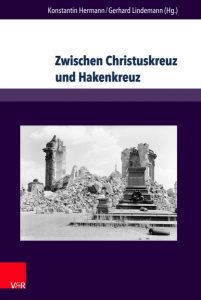 Commendably, the editors cover the various levels of complicity and resistance in their selection of biographical reconstructions. They do so systematically by dividing the volume into four parts. The first and longest part introduces the biographies of clergymen who embraced Nazi ideology and identified with the Deutsche Christen – the “German Christians,” a group within the Protestant parishes that saw no contradiction between Hitler and Luther, between Nazi ideology and church teachings (Knabe; Münnich; Coch; Fügner; Bohland; Axt). The second part covers four men belonging to the so-called “Mitte,” the center, who tried to walk a middle path between radicalized and Nazi-supporting clergy and those who opposed the Nazi takeover of church and society (Herz; Bruhns; Loesche; Gerber). The third and shortest part introduces two biographies of men of the Confessing Church (Bekennende Kirche), who prioritized faith in Christ over nationalist and völkisch ideologies and (partially) resisted the Nazi regime (von Kirchbach; Delekat). The last part documents the biographies of churchmen who were persecuted by the Nazis for political and racial reasons, including Protestant ministers who were classified as Jews (or mix-blooded) by the 1935 Nuremberg Laws (Stempel; Kaiser; Gottlieb; Starke; Grosse).
Commendably, the editors cover the various levels of complicity and resistance in their selection of biographical reconstructions. They do so systematically by dividing the volume into four parts. The first and longest part introduces the biographies of clergymen who embraced Nazi ideology and identified with the Deutsche Christen – the “German Christians,” a group within the Protestant parishes that saw no contradiction between Hitler and Luther, between Nazi ideology and church teachings (Knabe; Münnich; Coch; Fügner; Bohland; Axt). The second part covers four men belonging to the so-called “Mitte,” the center, who tried to walk a middle path between radicalized and Nazi-supporting clergy and those who opposed the Nazi takeover of church and society (Herz; Bruhns; Loesche; Gerber). The third and shortest part introduces two biographies of men of the Confessing Church (Bekennende Kirche), who prioritized faith in Christ over nationalist and völkisch ideologies and (partially) resisted the Nazi regime (von Kirchbach; Delekat). The last part documents the biographies of churchmen who were persecuted by the Nazis for political and racial reasons, including Protestant ministers who were classified as Jews (or mix-blooded) by the 1935 Nuremberg Laws (Stempel; Kaiser; Gottlieb; Starke; Grosse).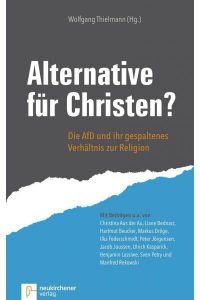 Among the incompatibilities cited by the authors are the AfD’s denigration of vulnerable groups (especially migrants and Muslims), its insistence on a homogeneous German Leitkultur, its political strategy (deliberate provocations and insults, distortions and “alternative facts,” manufacturing or intensifying anxieties), and its invocation of Christianity as an element of national identity rather than a universal faith and system of values. Nevertheless, they recognize that individual Christians have played a key role as founders and leaders of the party (including Frauke Petry, Bernd Lucke, and Konrad Adam on the Protestant side and Jörg Meuthen on the Catholic side). The group “Christen in der AfD” is another indicator that the party has made inroads among Christians, though very few pastors and priests have endorsed the AfD and many have been outspoken in their opposition.
Among the incompatibilities cited by the authors are the AfD’s denigration of vulnerable groups (especially migrants and Muslims), its insistence on a homogeneous German Leitkultur, its political strategy (deliberate provocations and insults, distortions and “alternative facts,” manufacturing or intensifying anxieties), and its invocation of Christianity as an element of national identity rather than a universal faith and system of values. Nevertheless, they recognize that individual Christians have played a key role as founders and leaders of the party (including Frauke Petry, Bernd Lucke, and Konrad Adam on the Protestant side and Jörg Meuthen on the Catholic side). The group “Christen in der AfD” is another indicator that the party has made inroads among Christians, though very few pastors and priests have endorsed the AfD and many have been outspoken in their opposition.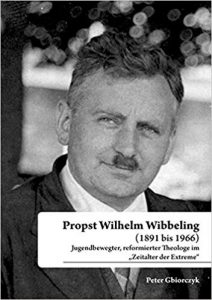 Wibbeling had just completed his theological examinations and practical training for the ministry when the First World War began. He fought, eventually becoming an officer, married shortly after the war ended, and was ordained in 1919. His subsequent career showed his lifelong commitment to the renewal and stability of his church as well as his own strong social-political convictions. His political leanings were socialist. He began his ministry as a youth pastor in the coal-mining town of Bochum in the Ruhr valley, where he reached out to working class, Catholic, socialist, and other youth organizations in the region, creating a coalition that focused especially on the problems of alcoholism among youth. A non-church colleague described him in those years as someone “who didn’t act like a pastor at all, avoided church language and was familiar with and understood the socialist movement.”
Wibbeling had just completed his theological examinations and practical training for the ministry when the First World War began. He fought, eventually becoming an officer, married shortly after the war ended, and was ordained in 1919. His subsequent career showed his lifelong commitment to the renewal and stability of his church as well as his own strong social-political convictions. His political leanings were socialist. He began his ministry as a youth pastor in the coal-mining town of Bochum in the Ruhr valley, where he reached out to working class, Catholic, socialist, and other youth organizations in the region, creating a coalition that focused especially on the problems of alcoholism among youth. A non-church colleague described him in those years as someone “who didn’t act like a pastor at all, avoided church language and was familiar with and understood the socialist movement.”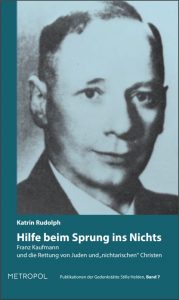 As Rudolph notes in her introduction, however, recent research has yielded new information about the group and important corrections to the earlier accounts (including those in my book), revealing a number of connections between Kaufmann and other people in Berlin who were attempting to help Jews. These findings have altered her understanding of how the Kaufmann group operated, and in this new edition she argues that there was not a distinct and independently operating “Kaufmann circle” but rather a wider network of “small alliances of helpers” who were loosely connected to Franz Kaufmann. This study therefore broadens our view of the group’s activities beyond the immediate circle around Kaufmann and explores the wider dynamics and patterns of assistance to Jews in wartime Berlin. Rudolph has also examined and corrected discrepancies in some of the postwar accounts, and her book serves as a critical study of how postwar narratives about rescue emerged.
As Rudolph notes in her introduction, however, recent research has yielded new information about the group and important corrections to the earlier accounts (including those in my book), revealing a number of connections between Kaufmann and other people in Berlin who were attempting to help Jews. These findings have altered her understanding of how the Kaufmann group operated, and in this new edition she argues that there was not a distinct and independently operating “Kaufmann circle” but rather a wider network of “small alliances of helpers” who were loosely connected to Franz Kaufmann. This study therefore broadens our view of the group’s activities beyond the immediate circle around Kaufmann and explores the wider dynamics and patterns of assistance to Jews in wartime Berlin. Rudolph has also examined and corrected discrepancies in some of the postwar accounts, and her book serves as a critical study of how postwar narratives about rescue emerged.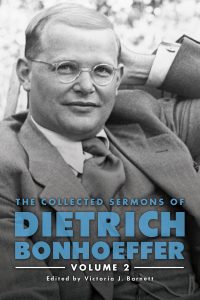 Three themes run through these sermons: the seriousness of Bonhoeffer’s Christianity, the insight of his responses to the social and political crises of the late Weimar and Nazi eras, and the resolution of his engagement in the Kirchenkampf (German Church Struggle).
Three themes run through these sermons: the seriousness of Bonhoeffer’s Christianity, the insight of his responses to the social and political crises of the late Weimar and Nazi eras, and the resolution of his engagement in the Kirchenkampf (German Church Struggle).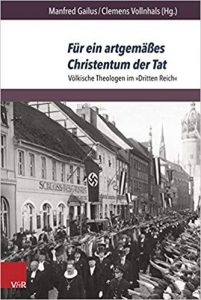 One of the editors of this volume, Manfred Gailus (a member of the editorial board of CCHQ), is a historian known to many or most of us as a prolific author and editor of books on Protestant churches in Nazi Germany. These include his Protestantismus und Nationalsozialismus: Studien zur Nationalsozialistischen Durchdringung des Sozialmilieus Berlin (Berlin, 2001), plus books such as Mir aber zerriss es das Herz: Der stille Widerstand der Elisabeth Schmitz (Göttingen, 2010), and Friedrich Weissler: Ein Jurist und bekennender Christ im Widerstand gegen Hitler (Göttingen, 2017). He also has co-edited books with colleagues, such as Nationalprotestantische Mentalitäten in Deutschland—1870-1970 (Göttingen, 2005), co-edited with Harmut Lehmann; Zerstrittene “Volksgemeinschaft:” Glaube, Konfession und Religion im Nationalsozialismus (Göttingen, 2011), co-edited with Armin Nolzen; as well as this volume co-edited with Clemens Vollnhals.
One of the editors of this volume, Manfred Gailus (a member of the editorial board of CCHQ), is a historian known to many or most of us as a prolific author and editor of books on Protestant churches in Nazi Germany. These include his Protestantismus und Nationalsozialismus: Studien zur Nationalsozialistischen Durchdringung des Sozialmilieus Berlin (Berlin, 2001), plus books such as Mir aber zerriss es das Herz: Der stille Widerstand der Elisabeth Schmitz (Göttingen, 2010), and Friedrich Weissler: Ein Jurist und bekennender Christ im Widerstand gegen Hitler (Göttingen, 2017). He also has co-edited books with colleagues, such as Nationalprotestantische Mentalitäten in Deutschland—1870-1970 (Göttingen, 2005), co-edited with Harmut Lehmann; Zerstrittene “Volksgemeinschaft:” Glaube, Konfession und Religion im Nationalsozialismus (Göttingen, 2011), co-edited with Armin Nolzen; as well as this volume co-edited with Clemens Vollnhals. Grünzig’s central question is about a building. What was the place of Potsdam’s Garrison Church in twentieth-century Germany? His answer is striking and sobering. Over a fifty-year period, the Garrison Church was the site of nationalist, National Socialist, military, and militaristic activity. Members of the congregation from Imperial Germany to the last days of Hitler’s regime loudly supported those causes, and the Protestant clergy, many of them military chaplains or veterans, promoted them from the pulpit. The church building was the site of memorials, rallies, processions, and ceremonies—to commemorate the Battle of Sedan, to mourn ten years since the signing of the Treaty of Versailles, to honor the anniversary of the death of Friedrich II, and to bless the banners of the Hitler Youth. It was both a symbol of an aggressive Fatherland and itself a force in creating and empowering that version of Germany.
Grünzig’s central question is about a building. What was the place of Potsdam’s Garrison Church in twentieth-century Germany? His answer is striking and sobering. Over a fifty-year period, the Garrison Church was the site of nationalist, National Socialist, military, and militaristic activity. Members of the congregation from Imperial Germany to the last days of Hitler’s regime loudly supported those causes, and the Protestant clergy, many of them military chaplains or veterans, promoted them from the pulpit. The church building was the site of memorials, rallies, processions, and ceremonies—to commemorate the Battle of Sedan, to mourn ten years since the signing of the Treaty of Versailles, to honor the anniversary of the death of Friedrich II, and to bless the banners of the Hitler Youth. It was both a symbol of an aggressive Fatherland and itself a force in creating and empowering that version of Germany.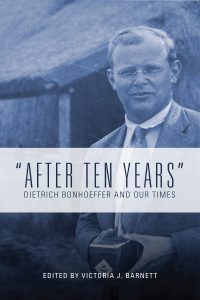 In her introductory chapter, Barnett begins with three italicized paragraphs in which she locates her reading of Bonhoeffer’s “After Ten Years.” On the one hand, she notes, “one must be cautious about drawing simplistic historical analogies,” especially with respect to Hitler, Nazism, and the Holocaust. “Nationalism, antisemitism, ethnocentrism, and populism have played a role in different historical periods and national contexts” (1). The grievances and resentments associated with these political movements always emerge out of specific social and cultural contexts. What is left unwritten is that the United States—indeed, the wider Western world—is currently threatened by the resurgence of just these sorts of antagonisms. Barnett continues, noting how important it is that citizens and institutions respond to such threats. Toleration of or compromise with ideologies of hatred will undermine and even destroy Western liberal political cultures. She suggests that this is a very real danger, given the fragility of ethical veneers and social conventions. Living in a time when accepted values and political norms are upended creates crises for individuals, religious bodies, and institutions of civil society, all of which struggle to adapt to or resist to these challenges. Barnett explains that these are the themes Bonhoeffer was addressing in his famous essay. As she writes, “his observations about what happens to human decency and courage when a political culture disintegrates continue to resonate around the world today” (2). This “introduction to the introduction” is very important, because it connects Bonhoeffer’s reflections about Nazi Germany to the upheaval of contemporary politics in the Age of Trump, even as it recognizes that this connection must take place in thoughtful, nuanced ways.
In her introductory chapter, Barnett begins with three italicized paragraphs in which she locates her reading of Bonhoeffer’s “After Ten Years.” On the one hand, she notes, “one must be cautious about drawing simplistic historical analogies,” especially with respect to Hitler, Nazism, and the Holocaust. “Nationalism, antisemitism, ethnocentrism, and populism have played a role in different historical periods and national contexts” (1). The grievances and resentments associated with these political movements always emerge out of specific social and cultural contexts. What is left unwritten is that the United States—indeed, the wider Western world—is currently threatened by the resurgence of just these sorts of antagonisms. Barnett continues, noting how important it is that citizens and institutions respond to such threats. Toleration of or compromise with ideologies of hatred will undermine and even destroy Western liberal political cultures. She suggests that this is a very real danger, given the fragility of ethical veneers and social conventions. Living in a time when accepted values and political norms are upended creates crises for individuals, religious bodies, and institutions of civil society, all of which struggle to adapt to or resist to these challenges. Barnett explains that these are the themes Bonhoeffer was addressing in his famous essay. As she writes, “his observations about what happens to human decency and courage when a political culture disintegrates continue to resonate around the world today” (2). This “introduction to the introduction” is very important, because it connects Bonhoeffer’s reflections about Nazi Germany to the upheaval of contemporary politics in the Age of Trump, even as it recognizes that this connection must take place in thoughtful, nuanced ways.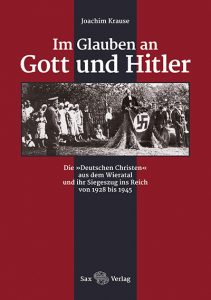 As the second subtitle reveals (“an annotated documentation”), the book is a descriptive representation of the German Christian Church Movement with a regional focus on the origins of the movement in the Wieratal near the city Altenburg. In his presentation, the author outlines the development chronologically: first of all, he describes how the two young vicars, Siegfried Leffler and Julius Leutheuser, who were inspired by National Socialism, began scouring for a small circle of like-minded people from 1927 onwards. Within a few years, this small circle was to become one of the most influential inner-church movements that controlled several Protestant churches during the time of the “Third Reich”. The theological worldview of the church movement was a symbiosis of (Protestant) Christianity and National Socialism, since they saw the direct action of God in Adolf Hitler and his movement.
As the second subtitle reveals (“an annotated documentation”), the book is a descriptive representation of the German Christian Church Movement with a regional focus on the origins of the movement in the Wieratal near the city Altenburg. In his presentation, the author outlines the development chronologically: first of all, he describes how the two young vicars, Siegfried Leffler and Julius Leutheuser, who were inspired by National Socialism, began scouring for a small circle of like-minded people from 1927 onwards. Within a few years, this small circle was to become one of the most influential inner-church movements that controlled several Protestant churches during the time of the “Third Reich”. The theological worldview of the church movement was a symbiosis of (Protestant) Christianity and National Socialism, since they saw the direct action of God in Adolf Hitler and his movement.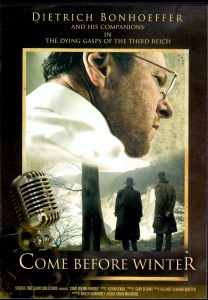 Come Before Winter begins by acknowledging the memoirs and writings of Sefton Delmer, Otto John, Sigismund Payne Best, and Dietrich Bonhoeffer as sources. It then asserts that “one of the tragedies of World War II was the refusal of President Roosevelt and Prime Minister Churchill to acknowledge the existence of a German resistance,” introducing the failed assassination attempt of July 20, 1944. From there viewers are introduced to Sefton Delmer, the British journalist (born and raised in Berlin) who operated several so-called black propaganda operations, broadcasting disinformation into Nazi Germany. The operation covered by the film was the German short-wave broadcast “Atlantic,” which used a powerful transmitter to broadcast jazz, invented personal announcements, and fake news throughout Germany and also to U-boats in the Atlantic during the later war years. Delmer’s goal was to demoralize German troops and to turn the German public against the Nazis. At several points in the film, broadcasts written by Delmer and Fleming (with information from Otto John) and read by Bernelle are re-enacted, in order to depict Delmer’s determined effort to use propaganda to defeat Germany. These scenes also serve as a vehicle for Otto John, a member of the July 20 assassination plot who had escaped to England, to explain the various efforts of the German Resistance to assassinate Adolf Hitler, along with Dietrich Bonhoeffer’s principled participation in the Resistance and his consequent arrest and detention in Tegel prison.
Come Before Winter begins by acknowledging the memoirs and writings of Sefton Delmer, Otto John, Sigismund Payne Best, and Dietrich Bonhoeffer as sources. It then asserts that “one of the tragedies of World War II was the refusal of President Roosevelt and Prime Minister Churchill to acknowledge the existence of a German resistance,” introducing the failed assassination attempt of July 20, 1944. From there viewers are introduced to Sefton Delmer, the British journalist (born and raised in Berlin) who operated several so-called black propaganda operations, broadcasting disinformation into Nazi Germany. The operation covered by the film was the German short-wave broadcast “Atlantic,” which used a powerful transmitter to broadcast jazz, invented personal announcements, and fake news throughout Germany and also to U-boats in the Atlantic during the later war years. Delmer’s goal was to demoralize German troops and to turn the German public against the Nazis. At several points in the film, broadcasts written by Delmer and Fleming (with information from Otto John) and read by Bernelle are re-enacted, in order to depict Delmer’s determined effort to use propaganda to defeat Germany. These scenes also serve as a vehicle for Otto John, a member of the July 20 assassination plot who had escaped to England, to explain the various efforts of the German Resistance to assassinate Adolf Hitler, along with Dietrich Bonhoeffer’s principled participation in the Resistance and his consequent arrest and detention in Tegel prison.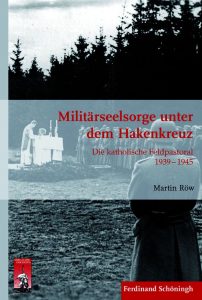 Röw’s intentions are to deliver a comprehensive structural and experiential history of Catholic military pastoral care in Germany, with a particular emphasis on providing a systematic study of chaplaincy (12). He has oriented himself solidly in the available historiography on the subject in both German and English and his archival research is impressively broad, gathering material from four archdiocesan archives (including Salzburg), eight diocesan archives (including one in Austria and one in the Netherlands), and several other state and private collections in Germany. His main source for primary documentation is the Archive of the Catholic Military Bishop, in Berlin, notably the Georg Werthmann collection. Until relatively recently, this rich compilation of chaplaincy-related material, produced by the man who served as second-in-command of the Catholic chaplaincy during the Second World War, was strikingly understudied; in the past four years, three books have appeared whose authors have extensively mined its records.
Röw’s intentions are to deliver a comprehensive structural and experiential history of Catholic military pastoral care in Germany, with a particular emphasis on providing a systematic study of chaplaincy (12). He has oriented himself solidly in the available historiography on the subject in both German and English and his archival research is impressively broad, gathering material from four archdiocesan archives (including Salzburg), eight diocesan archives (including one in Austria and one in the Netherlands), and several other state and private collections in Germany. His main source for primary documentation is the Archive of the Catholic Military Bishop, in Berlin, notably the Georg Werthmann collection. Until relatively recently, this rich compilation of chaplaincy-related material, produced by the man who served as second-in-command of the Catholic chaplaincy during the Second World War, was strikingly understudied; in the past four years, three books have appeared whose authors have extensively mined its records.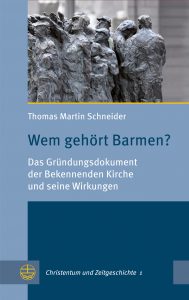 In this account by the Koblenz-Landau church historian, one can not ignore the remarkably sympathetic treatment (for example, pp. 62 f., 72 ff.) of the Lutheran churches which adapted to the Nazi regime and which were skeptical or even hostile to the Barmen project from the outset. From today’s point of view, a critical church-historical assessment would seem more appropriate. Also, an up-to-date church history should leave behind terms from the time of the Church Struggle such as “intact” and “destroyed” churches. For the three large Lutheran regional churches (especially that of Hanover), with their far-reaching adjustment to the regime, the label “intact” should really be dispensed with. And for divided regional churches, such as the great Old Prussian Union Church, it would be more appropriate to speak of “self-destruction.” Although the author deals comparatively with the “Altona Confession” (1932), he deals too briefly or not at all with the 1936 memorandum of the 2nd Provisional Church Leadership (of the Confessing Church) to Hitler or the memoranda by Margarete Meusel (1935) and Elisabeth Schmitz (1935/36) on behalf of Protestant “non-Aryans” and persecuted Jews. A comparative chapter involving these and other important manifestations of the period of the Church Struggle would be well placed here.
In this account by the Koblenz-Landau church historian, one can not ignore the remarkably sympathetic treatment (for example, pp. 62 f., 72 ff.) of the Lutheran churches which adapted to the Nazi regime and which were skeptical or even hostile to the Barmen project from the outset. From today’s point of view, a critical church-historical assessment would seem more appropriate. Also, an up-to-date church history should leave behind terms from the time of the Church Struggle such as “intact” and “destroyed” churches. For the three large Lutheran regional churches (especially that of Hanover), with their far-reaching adjustment to the regime, the label “intact” should really be dispensed with. And for divided regional churches, such as the great Old Prussian Union Church, it would be more appropriate to speak of “self-destruction.” Although the author deals comparatively with the “Altona Confession” (1932), he deals too briefly or not at all with the 1936 memorandum of the 2nd Provisional Church Leadership (of the Confessing Church) to Hitler or the memoranda by Margarete Meusel (1935) and Elisabeth Schmitz (1935/36) on behalf of Protestant “non-Aryans” and persecuted Jews. A comparative chapter involving these and other important manifestations of the period of the Church Struggle would be well placed here. Lorenz’s goal is to compare New Testament passages from The Message of God with the Luther Bible, the standard translation, and the original Greek text. For this purpose, Lorenz has chosen three central terms by means of which she tries to analyze the new interpretation in The Message of God. Chapter 2 deals with the Messiah concept and the relationship between Jesus and Judaism. Chapter 3 places the concept of sacrifice at the heart of the comparison. Chapter 4 deals with the portrayal of Jesus in the New Testament traditions in comparison with Jesus’ presentation in The Message of God. The focus on concepts rather than merely on individual passages is very welcome, since, for example, in dealing with the Messiah concept, the entire Christology of The Message of God and thus of the German Christians can be derived, as Lorenz rightly states (83).
Lorenz’s goal is to compare New Testament passages from The Message of God with the Luther Bible, the standard translation, and the original Greek text. For this purpose, Lorenz has chosen three central terms by means of which she tries to analyze the new interpretation in The Message of God. Chapter 2 deals with the Messiah concept and the relationship between Jesus and Judaism. Chapter 3 places the concept of sacrifice at the heart of the comparison. Chapter 4 deals with the portrayal of Jesus in the New Testament traditions in comparison with Jesus’ presentation in The Message of God. The focus on concepts rather than merely on individual passages is very welcome, since, for example, in dealing with the Messiah concept, the entire Christology of The Message of God and thus of the German Christians can be derived, as Lorenz rightly states (83).